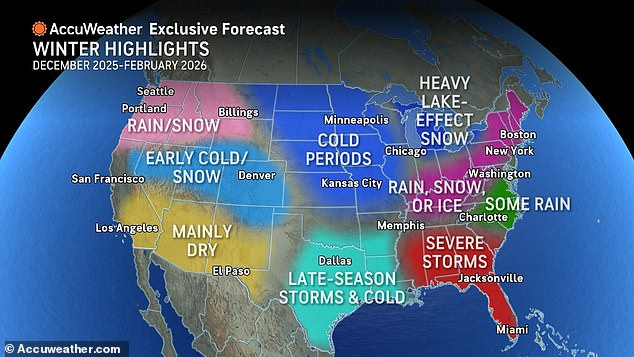Meteorologists are already predicting what the winter months will bring, with some regions of the US expected to see less snow than last year, and nor’easters anticipated to ravage parts of the Northeast.
Paul Pastelok, chief meteorologist for AccuWeather’s long-range forecasting team, told the Daily Mail that while he didn’t expect above normal snowfall for the winter season, he warned that those in the Northeast should brace for nor’easters and it would still be a harsh winter.
Pastelok explained that the nor’easter over this weekend is on trend with what is to come, as rapidly developing storms come in off the East Coast.
‘People may say, “Well, you’re forecasting less snow, so it doesn’t look like a harsh winter.” That’s not true because the snow and the ice and the mixed precipitation are worse than having the snow sometimes,’ he said.
He added that the East Coast could still expect stormy patterns throughout the winter season, even as early as December.
‘We have to be ready for the possibility of a sneaky storm or two in December, and then a lot of mixing storms in January in the East,’ Pastelok said.
The prediction may be a surprise to those who have been enjoying the recent 80-degree heat in the area but Pastelok said that those days would feel like ‘a far memory’ by the end of the month.

Snow is expected to be below average across the East Coast but parts of the Midwest and Northeast will still be hit with snow. A forecast for December to February is seen above

Paul Pastelok, chief meteorologist for AccuWeather’s long-range forecast team, is predicting less snow this winter but with the potential for more nor’easters. Pictured: Winter Storm Lorraine hits Connecticut in February 2023

The East Coast is expected to see below-average snow, while parts of the Northwest, Midwest and Great Lakes region are likely to see above-average snow. Overall, the country is predicted to see less snow this year
He also dispelled a common misconception – that warm weather in fall leads to colder temperatures in winter.
‘A lot of times, that doesn’t always work out. The tropics have a major influence on our patterns here in North America during the fall season and even in the early winter.

Pastelok said Northeasterners should prepare for more nor’easters this winter
‘I don’t see a lot of recurving tropical systems toward the end of October; that pattern may be more short-lived in the fall,’ he added.
AccuWeather expects that seasonal snow totals may fall below the historical average, with Northeasterners facing storms with a mix of rain and snow.
For example, New York typically sees 29.8 inches of snow a year based on averages from 1991 to 2020. This winter, AccuWeather predicts the city will receive between 17 and 21 inches. The company shared the graphs below with predictions for each region.
Temperatures are expected to drop in December before thawing in January.
However, the cold will return with a vengeance in February, with frigid air across central and eastern states.
These cold temperatures are also expected to affect Texas and the Gulf Coast in January or early February, potentially bringing snow and ice.


Snowfall predictions across the US are expected to range from 13 to 100 inches this winter. Predictions in inches from AccuWeather are seen above

However, certain parts of the Eastern US, such as Buffalo, can expect 90 to 100 inches of snow this winter (Pictured: Fans of the Buffalo Bills covered in snow at a game last December)

Pastelok said this winter could still be a harsh one with storms that mix ice and rain. File photo: Brooklyn, New York, in February 2023

Pastelok predicted more nor’easters for the Northeast as a storm develops off the East Coast
Other regions across the country can brace for heavy snowfall and extreme weather conditions throughout the winter season.
Pastelok said that Middle America, including parts of the Ohio Valley, can expect severe weather at the end of January into February.
He added that the Northern Rockies, the Great Plains, through Tennessee, and the Southeast can expect the worst weather.
The Upper Great Lakes, especially, will likely face heavy snowfall, and Northern cities around Buffalo should anticipate 90 to 100 inches of snow.
Bitterly cold temperatures are expected in February, with the potential for even more snow in these regions.
Tropical storms are also far from over, with Jerry hitting the central Atlantic Ocean and the Leeward Islands this past week.
Pastelok said AccuWeather’s long-range meteorologists expect at least another three major storms this season after Jerry.
The team is keeping a close eye on the Western Caribbean and the Southwest Gulf for potentially extreme weather and hurricanes.

Cities across the East Coast are bracing for heavy rain as a nor’easter builds

A home in Erie, PA, last year when snow blanketed New York and Pennsylvania in December

Areas such as South Carolina, Arizona and New Mexico may still be vulnerable to wildfires until February
Meanwhile, areas such as Southern California, Arizona and New Mexico may still be vulnerable to wildfires.
Pastelok noted that the fire season now continues into winter, and dry areas susceptible to flames may not get a break until February.
This article was originally published by a www.dailymail.co.uk . Read the Original article here. .

